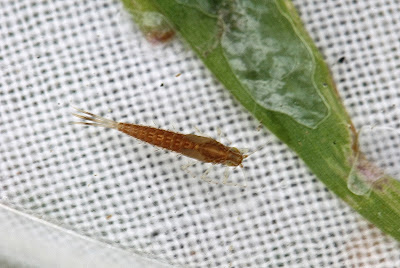It was a good morning at the Rivanna at Crofton --despite the cloudy, humid conditions that made getting good photos a challenge. I found a number of small minnow mayflies that appear to be a new species for us -- Labiobaetis propinquus (formerly Pseudocloen propinquum). I say "appear to be" since THE defining characteristic is one that requires slide mounting of the labrum to look for small setae, something I simply can't do. Still, there are other key features that we clearly can see, and, L. propinquus was Beaty's guess when he looked at my photos. (In the first edition of "The Ephemeroptera of North Carolina," this species is identified as Pseudocloen propinquum (p. 13) but that has been changed to Labiobaetis propinquus in the second edition (p. 19).)
Before we look at Beaty's species description, it's important to note that these nymphs come in light and dark forms, and I found both this morning. Here are two of the dark ones.
Labiobaetis propinquus -- nymphs 4-6 mm; submarginal setae on labrum simple with paired setae; tracheation of gills not extensive; usually has distinct color pattern, often with terga 2, 5, and 10 pale and typically with dark elongated spots down dorsal centerline. A dark morph exists...with head, thorax and abdomen dark and with sterna 1-4 or 5 with medial area pale. However, labral setation confirms this as L. propinquus. Most common Labiobaetis in NC furing spring through fall. Widespread and facultative. ("The Ephemeroptera of North Carolina," 2nd edition)
1. The nymphs that I found this morning were 4.5 mm and 5 mm.
2. I, unfortunately, have no way to check on the labral setation.
3. The gill tracheation is simple.
4. The pale shading of terga 2, 5, and 10 is most easily seen on the dark nymphs.
5. While the elongated dark spots are more easily seen on lighter nymphs.
6. To see the pale medial areas on sterna 1-5, we need a microscope view.
I think the evidence is pretty convincing though I may send some specimens to Beaty for confirmation.
Labiobaetis propinquus is a fairly tolerant species -- no surprise there -- with a TV of 5.8
______________________
But I was in for another treat at the Rivanna this morning. I found a fair sized Giant stonefly, and I think I now know the species that inhabits this river: Pteronarcys dorsata.
There are two keys to this identification: 1) the "lateral angles of [the] pronotum [are produced, anterolateral ones almost hook-like," and 2) there are "no lateral projections on [the] abdominal segments." (Beaty, "The Plecoptera of North Carolina," p. 28)
If we want to see lateral projections on the abdominal segments of a Giant stonefly, we look at P. biloba!
Pteronarcys dorsata is the most tolerant Giant stonefly we see with a TV of 2.4. The other Giants we've seen -- P. biloba and P. proteus -- have tolerance values of 0.0 and 0.4 respectively.
Pretty nice findings today, and I got some nice photos of a male H. curiosum as well as a couple of Tricos (Little stout crawler mayflies -- Leptohyphidae).
________________
Labiobaetis propinquus
















No comments:
Post a Comment